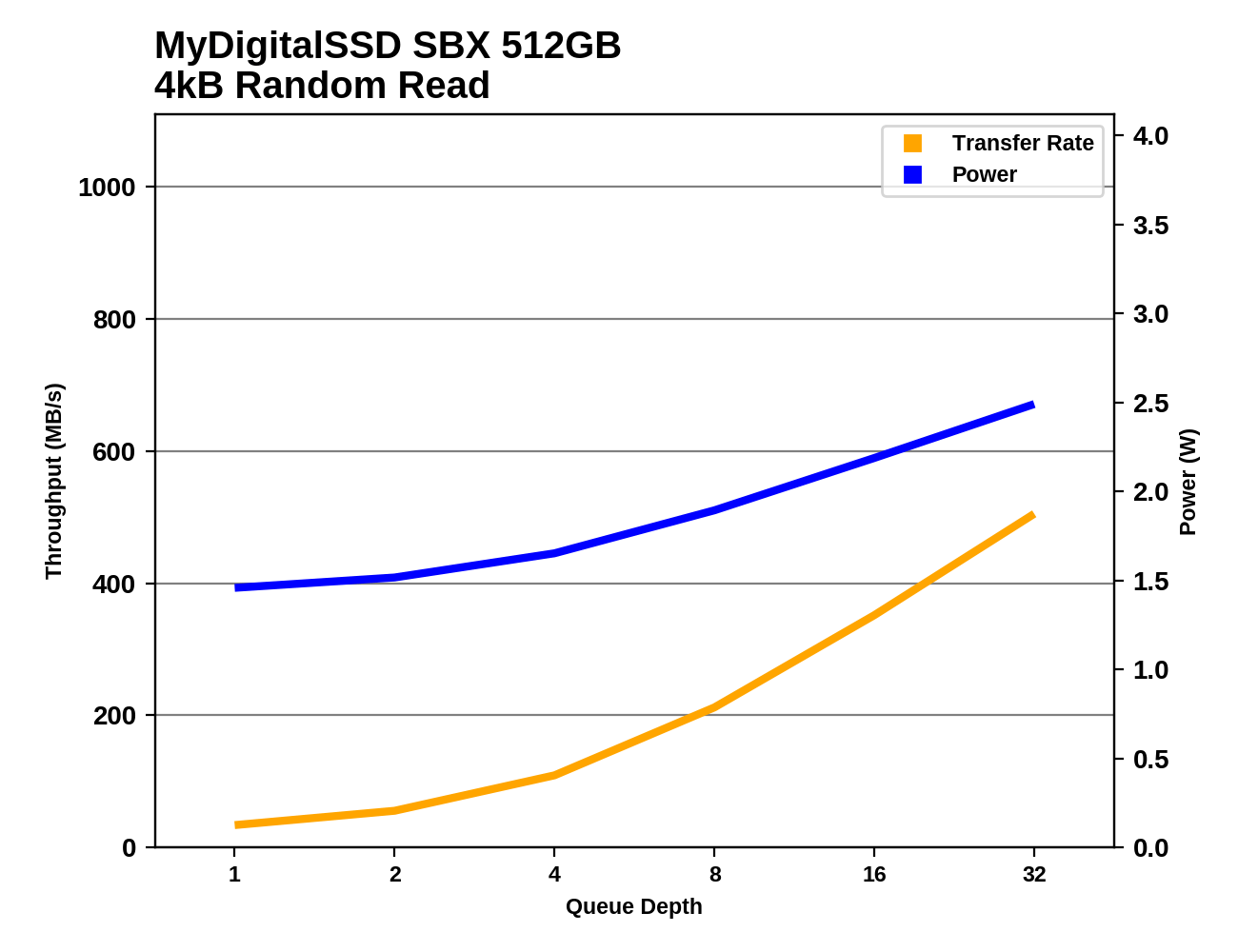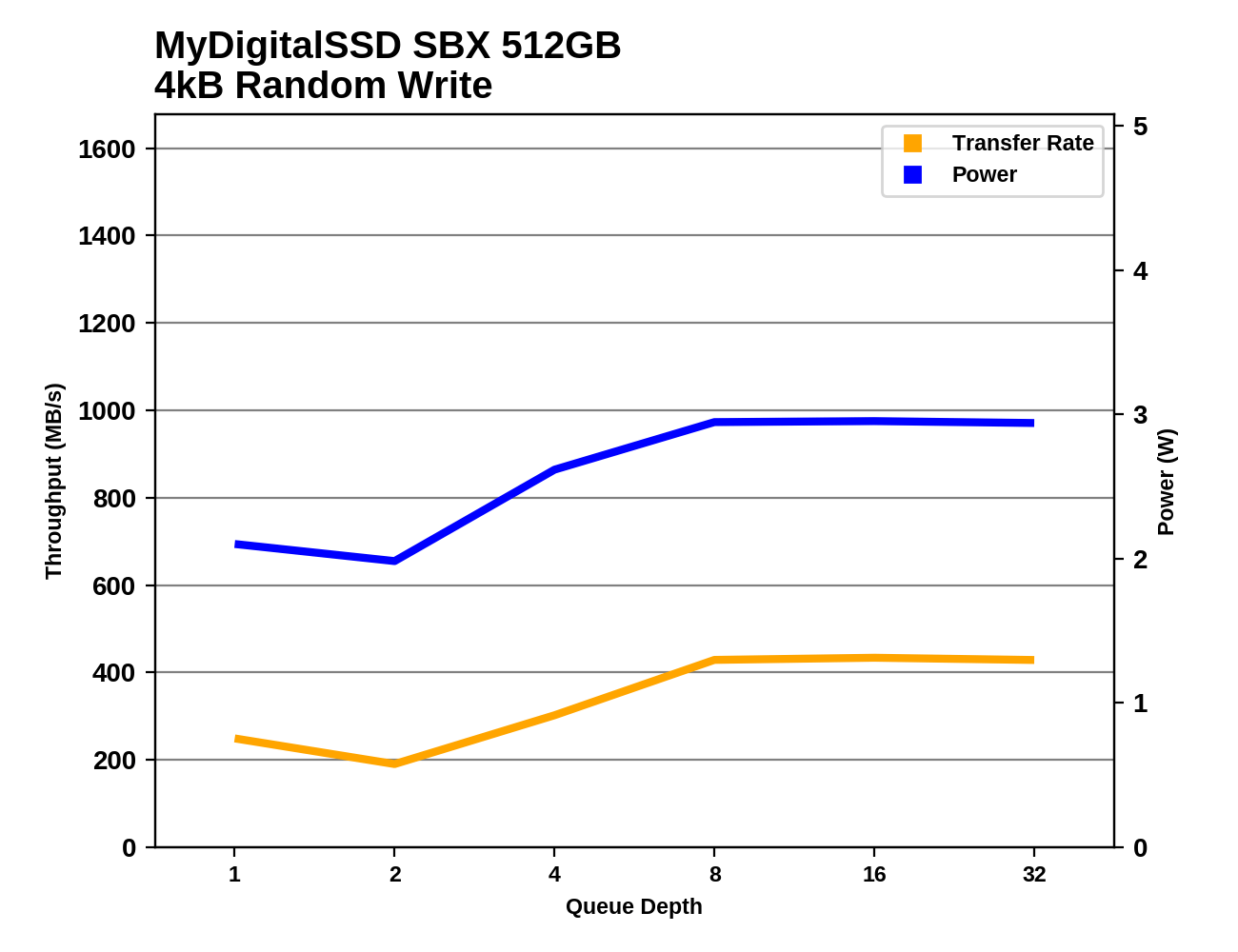The MyDigitalSSD SBX SSD Review: NVMe On The Cheap
by Billy Tallis on May 1, 2018 8:05 AM ESTRandom Read Performance
Our first test of random read performance uses very short bursts of operations issued one at a time with no queuing. The drives are given enough idle time between bursts to yield an overall duty cycle of 20%, so thermal throttling is impossible. Each burst consists of a total of 32MB of 4kB random reads, from a 16GB span of the disk. The total data read is 1GB.

The QD1 burst random read performance of the MyDigitalSSD SBX is relatively poor, falling behind the top tier of SATA SSDs. The SBX is faster than the Intel SSD 600p, but the newer Intel 760p is more than 50% faster than the SBX.
Our sustained random read performance is similar to the random read test from our 2015 test suite: queue depths from 1 to 32 are tested, and the average performance and power efficiency across QD1, QD2 and QD4 are reported as the primary scores. Each queue depth is tested for one minute or 32GB of data transferred, whichever is shorter. After each queue depth is tested, the drive is given up to one minute to cool off so that the higher queue depths are unlikely to be affected by accumulated heat build-up. The individual read operations are again 4kB, and cover a 64GB span of the drive.

The ranking of the MyDigitalSSD SBX doesn't change much on the longer random read test, but many of the faster drives have traded places. Even with some higher queue depths involved, the SBX can't quite match the best SATA SSDs for random read performance.
 |
|||||||||
| Power Efficiency in MB/s/W | Average Power in W | ||||||||
The MyDigitalSSD SBX draws substantially less power during the random read test than most NVMe SSDs, which leads to an efficiency score that is about average. Many of the SATA drives have a significant efficiency advantage, as do several of the fastest NVMe SSDs.
 |
|||||||||
The 512GB SBX clearly has room for further throughput increases past QD32, but the smaller capacities start falling behind past QD4 and are close to saturation by QD32. The Intel SSD 760p shows similar performance scaling that is almost always a bit faster than the SBX, but also requires significantly more power across the board.
Random Write Performance
Our test of random write burst performance is structured similarly to the random read burst test, but each burst is only 4MB and the total test length is 128MB. The 4kB random write operations are distributed over a 16GB span of the drive, and the operations are issued one at a time with no queuing.

The burst random write performance of the MyDigitalSSD SBX can't match the unusually good performance from the Intel SSD 760p, but it is certainly reasonable for a low-end NVMe SSD. The 128GB SBX is about 30% slower than the larger capacities, but is still faster than the SATA drives.
As with the sustained random read test, our sustained 4kB random write test runs for up to one minute or 32GB per queue depth, covering a 64GB span of the drive and giving the drive up to 1 minute of idle time between queue depths to allow for write caches to be flushed and for the drive to cool down.

On the longer random write test, SLC cache size limitations come into play and the 128GB drives end up near the bottom of the chart, above only the DRAMless SATA drives. The larger capacities aren't quite as fast as the top SATA SSDs, and the more expensive NVMe SSDs offer more than double the throughput of the SBX even at these relatively low queue depths.
 |
|||||||||
| Power Efficiency in MB/s/W | Average Power in W | ||||||||
The SBX is again using much less power than the other NVMe SSDs, but its poor performance leaves it with a fairly low efficiency score.
 |
|||||||||
Performance from the SBX drops during the early phases of the random write test as the SLC write cache is quickly filled. Only the 512GB model manages to recover performance later at high queue depths, but its eventual limit is not far above the performance offered by SATA drives.










46 Comments
View All Comments
Samus - Tuesday, May 1, 2018 - link
Ditto. I think it'd crazy to use a 2.5" over an M2 if you have the M2 slot available, especially since M2 SATA drives are often cheaper than 2.5" drives (because they are less expensive to manufacture, and the OEM market is larger.)And as far as SATA M2 drives, if you have an M2 slot that supports NVMe, it's hard to justify not using an NVMe SSD when the cost difference is less than 20%...I picked up the WD Black 512GB NVMe drive last week for $150. A decent 540GB class SATA M2 SSD is at least $120.
Death666Angel - Tuesday, May 1, 2018 - link
If every dollar counts and the performance increase is small or won't be used, it's pretty easy to justify getting a SATA M.2 drive instead of an NVME one.Death666Angel - Tuesday, May 1, 2018 - link
Especially since small capacities are likely to be very close in speed, when comparing NMVE and SATA M.2.Byte - Tuesday, May 1, 2018 - link
As someone who does a lot of testing/tweaking, i love the easy formfactor, but hate having to screw and unscrew. We really need a tooless update.MajGenRelativity - Thursday, May 3, 2018 - link
Honestly, I find it about the same amount of time/difficulty to (un)screw an M.2 drive as it is to work with even a toolless 2.5" drive. Unless the M.2 drive is under the GPU, in which case that really annoys meleexgx - Tuesday, May 1, 2018 - link
Still £/$30 more for a customer who is not going to benefit from the nvme ssd (and less money for you)I hardly notice the difference between the sata and nvme ssd my self, main difference is them above 1GB/s speeds but day to day usage I don't really notice much the difference between them unless I am looking for the difference (as long as it's Not a HDD even a slow ssd is many times faster then a hdd)
Do Samsung 850 evo have am issue if they have been left on for to long (like 30 days) as my 850 evo just crap it self out smart fail at Bios and can't read it (only done basic not hirions boot CD yet)
MajGenRelativity - Thursday, May 3, 2018 - link
Actually, I'd technically make a little more money if I sold them an NVMe SSD (my labor cost scales with price of parts), but they wouldn't benefit from it, so I generally don't recommend them. 850 Evo's don't normally have that issue.peevee - Tuesday, May 1, 2018 - link
AT, how about a couple of user-reproducible, real life tests? Compilation of a large software package. Unzipping a large archive. Recoding video. Just to demonstrate the scale of improvement the buyers could actually SEE.SanX - Wednesday, May 2, 2018 - link
Two reasons come instantly. Because only salespeople left in IT. No one even discuss calling lawyers for such confusing people blatant claims like 1600MB/second read speed this product has. And because Windows for example will load something like in 17.6 seconds instead of 17.9 with this drive vs SSD.Funny also is that 2-3 times slower drive which does not deliver at all is just 25-30% cheaper then the leaders.
peevee - Friday, May 4, 2018 - link
This site is often for people for assemble their own PCs and/or choose what to buy for their companies. I'd think a few reproducible, real life tests vs proprietary and compressed tests would show the value of improvements.Maybe it is what AT really is afraid of, because tests show the improvements which do not exist in real life?